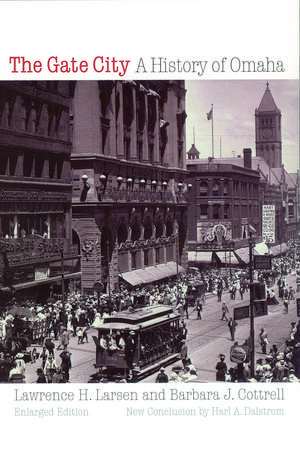The Gate City: A History of Omaha (Enlarged Edition)
Autor Lawrence H. Larsen, Barbara J. Cottrell Larsonen Limba Engleză Paperback – 30 iun 1997
Preț: 154.44 lei
Nou
Puncte Express: 232
Preț estimativ în valută:
29.55€ • 30.94$ • 24.45£
29.55€ • 30.94$ • 24.45£
Carte disponibilă
Livrare economică 17-31 martie
Preluare comenzi: 021 569.72.76
Specificații
ISBN-13: 9780803279674
ISBN-10: 0803279671
Pagini: 356
Ilustrații: Illus
Dimensiuni: 140 x 216 x 26 mm
Greutate: 0.48 kg
Ediția:Enlarged
Editura: Nebraska Paperback
Colecția University of Nebraska Press
Locul publicării:United States
ISBN-10: 0803279671
Pagini: 356
Ilustrații: Illus
Dimensiuni: 140 x 216 x 26 mm
Greutate: 0.48 kg
Ediția:Enlarged
Editura: Nebraska Paperback
Colecția University of Nebraska Press
Locul publicării:United States
Notă biografică
Lawrence H. Larsen is a professor of history at the University of Missouri–Kansas City. He is the author of The Urban South: A History (1990), Federal Justice in Western Missouri: The Judges, the Cases, the Times (1994), and other books.
Barbara J. Cottrell is a historian with the National Archives–Central Plains Region.
Harl A. Dalstrom is a professor of history at the University of Nebraska at Omaha.
Recenzii
“Lawrence Larsen and his wife Barbara Cottrell have written a marvelous urban biography. They have done what other historians often fail to do—relate local happenings to the larger regional and national picture. And Larsen and Cottrell have skillfully used sophisticated historical works and concepts, incorporating them in an understandable fashion. Throughout this book the authors write in a delightful manner; they make you want to visit Omaha!”—North Dakota History
“[The authors] organize their splendid urban biography around a limited number of events of national magnitude. The husband-wife team take as their story’s major units the building of the transcontinental railroad, the penetration of the Great Plains by homesteaders, the establishment of the meat packing industry, and the creation of an elaborate national defense system. They fill in their story with intriguing descriptions of the push-and-pull factors that brought diverse ethnic groups to Omaha in the years since 1854—the years when town promoters first settled at the Missouri River ferry landing in the newly established Nebraska territory. Because their narrative is so well organized, their treatment of political, social, and cultural affairs is clear and cohesive, while their discussion of urban unrest, vice, and crime remains tightly linked to the general outlines of their lively portrait of Omaha’s history.”—Business History Review

















